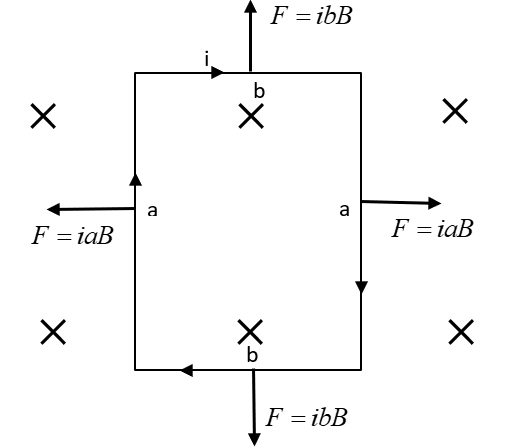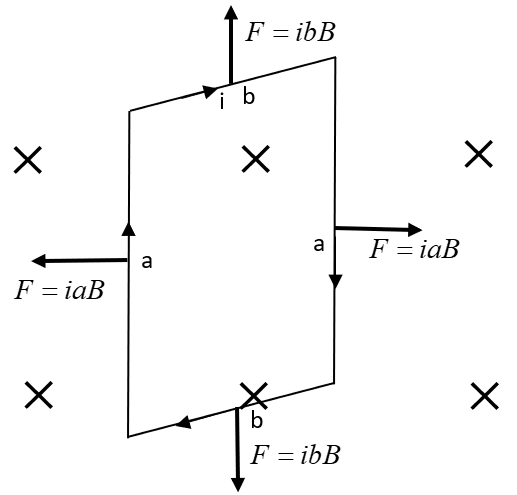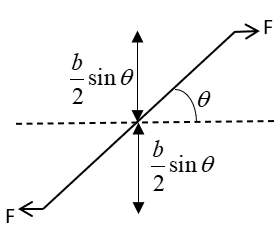
Find out the expression for the torque acting on a coil having an area of cross-section, $A$ , number of turns $n$ , placed in a magnetic field of intensity $B$ , making an angle $\theta $ with the normal of the coil, when a current $i$ is flowing it.
A. $niAB\tan \theta $
B. $niAB\cos \theta $
C. $niAB\sin \theta $
D. $niAB$
Answer
218.7k+ views
Hint:The above question is asking you to derive the formula for the torque that a current carrying coil experiences when it is placed in a magnetic field. Consider a rectangular loop and calculate the net torque it experiences, when the axis of the loop is placed at an angle to the magnetic field.
Complete answer:
Consider a rectangular loop of sides $a$ and $b$ , carrying current $i$ , placed in a uniform magnetic field of intensity $B$ .
Each side of the loop will act like a current carrying wire in a magnetic field and hence, will experience force equivalent to $iBa\sin ({90^ \circ })$ or $iBb\sin ({90^ \circ })$ depending on the length of the wire.
Let the loop be placed in such a way that the area vector (normal to the area of the loop), is along the direction of the magnetic field.

In this case, the net force on the loop will be 0 and the net torque on the loop will be 0 as well as they all cancel each other.
Now, let us rotate the coil by some angle $\theta $ .

In this case the net force on the loop will still be 0. However, the torque is not. Hence, the current carrying loop experienced a torque when placed in a magnetic field.
The vertical forces cancel each other but the horizontal forces did not as they are not having the same line of action.
As, both the horizontal forces are rotating the loop in the same direction, therefore,
${\tau _{{\text{net}}}} = F \times \left( {{\text{the perpendicular distance}}} \right) + F \times \left( {{\text{the perpendicular distance}}} \right)$

This perpendicular distance is equivalent to $\dfrac{b}{2}\sin \theta $ as seen in the figure.
Hence, ${\tau _{{\text{net}}}} = 2F \times \dfrac{b}{2}\sin \theta = Fb\sin \theta $ .
Now, this force $F$ is equal to $iBa\sin ({90^ \circ }) = iBa$ as said above.
Hence, substituting this, we get:
${\tau _{{\text{net}}}} = (iBa)(b\sin \theta )$
As area of the loop, $A = ab$ ,
${\tau _{{\text{net}}}} = iAB\sin \theta $
Considering there are $n$ number of turns in the coil, the net torque on the coil will be:
${\tau _{{\text{net}}}} = niAB\sin \theta $
Hence, the correct option is C.
Note:Torque is a force that rotates a body, that is, it is a rotational equivalent of force. In the above derivation, it is important to consider how the forces cancel out each other in both the cases but the torque does not. It is because only the vertical forces cancelled each other but the horizontal forces did not. This happened because the line of action of these horizontal forces were different. If they were along the same line (the first case), they would have cancelled each other as well and the net torque would have been 0.
Complete answer:
Consider a rectangular loop of sides $a$ and $b$ , carrying current $i$ , placed in a uniform magnetic field of intensity $B$ .
Each side of the loop will act like a current carrying wire in a magnetic field and hence, will experience force equivalent to $iBa\sin ({90^ \circ })$ or $iBb\sin ({90^ \circ })$ depending on the length of the wire.
Let the loop be placed in such a way that the area vector (normal to the area of the loop), is along the direction of the magnetic field.

In this case, the net force on the loop will be 0 and the net torque on the loop will be 0 as well as they all cancel each other.
Now, let us rotate the coil by some angle $\theta $ .

In this case the net force on the loop will still be 0. However, the torque is not. Hence, the current carrying loop experienced a torque when placed in a magnetic field.
The vertical forces cancel each other but the horizontal forces did not as they are not having the same line of action.
As, both the horizontal forces are rotating the loop in the same direction, therefore,
${\tau _{{\text{net}}}} = F \times \left( {{\text{the perpendicular distance}}} \right) + F \times \left( {{\text{the perpendicular distance}}} \right)$

This perpendicular distance is equivalent to $\dfrac{b}{2}\sin \theta $ as seen in the figure.
Hence, ${\tau _{{\text{net}}}} = 2F \times \dfrac{b}{2}\sin \theta = Fb\sin \theta $ .
Now, this force $F$ is equal to $iBa\sin ({90^ \circ }) = iBa$ as said above.
Hence, substituting this, we get:
${\tau _{{\text{net}}}} = (iBa)(b\sin \theta )$
As area of the loop, $A = ab$ ,
${\tau _{{\text{net}}}} = iAB\sin \theta $
Considering there are $n$ number of turns in the coil, the net torque on the coil will be:
${\tau _{{\text{net}}}} = niAB\sin \theta $
Hence, the correct option is C.
Note:Torque is a force that rotates a body, that is, it is a rotational equivalent of force. In the above derivation, it is important to consider how the forces cancel out each other in both the cases but the torque does not. It is because only the vertical forces cancelled each other but the horizontal forces did not. This happened because the line of action of these horizontal forces were different. If they were along the same line (the first case), they would have cancelled each other as well and the net torque would have been 0.
Recently Updated Pages
A square frame of side 10 cm and a long straight wire class 12 physics JEE_Main

The work done in slowly moving an electron of charge class 12 physics JEE_Main

Two identical charged spheres suspended from a common class 12 physics JEE_Main

According to Bohrs theory the timeaveraged magnetic class 12 physics JEE_Main

ill in the blanks Pure tungsten has A Low resistivity class 12 physics JEE_Main

The value of the resistor RS needed in the DC voltage class 12 physics JEE_Main

Trending doubts
JEE Main 2026: Application Form Open, Exam Dates, Syllabus, Eligibility & Question Papers

Derivation of Equation of Trajectory Explained for Students

Hybridisation in Chemistry – Concept, Types & Applications

Understanding the Angle of Deviation in a Prism

Understanding Collisions: Types and Examples for Students

Understanding Atomic Structure for Beginners

Other Pages
JEE Advanced Marks vs Ranks 2025: Understanding Category-wise Qualifying Marks and Previous Year Cut-offs

How to Convert a Galvanometer into an Ammeter or Voltmeter

Understanding Centrifugal Force in Physics

JEE Main Marking Scheme 2026- Paper-Wise Marks Distribution and Negative Marking Details

Degree of Dissociation: Meaning, Formula, Calculation & Uses

Understanding Electromagnetic Waves and Their Importance




